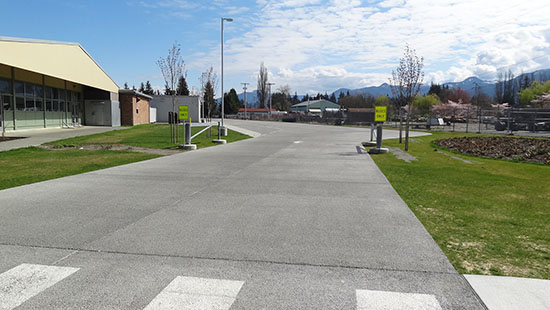|
Subscribe / Renew |
|
|
Contact Us |
|
| ► Subscribe to our Free Weekly Newsletter | |
| home | Welcome, sign in or click here to subscribe. | login |
Construction
| |
 |
May 9, 2014
Cascade Middle School
SUSTAINABLE MERIT
Location: Sedro-Woolley
Owner/developer: Sedro-Woolley School District
Project team: Colacurcio Brothers Construction, general contractor; Harthorne Hagen Architects, architect; 2020 Engineering, structural engineer; PCS Structural Solutions, civil engineer; LangCo NW, concrete contractor; Concrete Nor’west, ready-mix supplier
Cascade Middle School in the Sedro-Woolley School District recently underwent a $20 million renovation.
Priorities included protecting the environment and providing safe access for buses, faculty and staff, and parents dropping off students.
When considering sustainable stormwater management strategies for the site, infiltration was identified as the preferred method. Several infiltration methods were evaluated, and ultimately it was decided to install permeable pavement because of the large amount of infiltration area beneath the pavement.
Other infiltration strategies concentrate the stormwater in smaller facilities, which require deeper sections to provide enough stormwater storage prior to infiltration. Pervious pavement meets two needs by providing a pavement surface as well as a stormwater management facility.
Of the types of permeable pavements currently available, pervious concrete has the highest level of durability and structural integrity, especially for the heavy bus traffic. It also has a light reflective surface, which helps to mitigate the heat-island effect. Because the pervious pavement areas did not need any conventional stormwater components (such as catch basins, pipes and vaults) it was also the most economical choice.
Pervious concrete has been shown to provide several pollutant-removal mechanisms inherent to the paving structure. These mechanisms include stomwater volume reduction (through infiltration and evaporation), reduced spray and vehicle washoff, biological degradation, filtration, absorption and volatilization. Through these mechanisms, the typical pollutants removed include hydrocarbons, metals, sediment, nutrients, chloride, bacteria and polycyclic aromatic hydrocarbons.
All of these characteristics help the project earn credits under the Washington Sustainable Schools Protocol, the green building standard for school construction in Washington state.
Pervious concrete covers nearly 4 acres of the site. Parking areas were constructed with a 6-inch-thick section, the bus lane was constructed with an 8-inch-thick section, and the sidewalks were constructed with a thickness of four inches, totaling 3,500 cubic yards.
The pervious concrete mix includes admixtures and Fibermesh 150 for added durability and hydration control. The increased thickness as well as the fiber and admixtures in the bus lanes give additional strength to accommodate the heavy axle loads of the buses.
In the specifications for the project, it was stated that the installer must be certified through the National Ready Mixed Concrete Association’s Pervious Concrete Contractor Certification Program, which ensured that the installer was experienced and knowledgeable in the field.
In addition to the benefits listed above, the pervious concrete provides an educational opportunity for the students of Cascade Middle School. By understanding why the pavement is pervious, and what benefits it provides, the students have an opportunity to learn about stormwater management and how their actions can affect the health of our communities, watersheds and ecosystems.
The parking lots and sidewalks actually act as outdoor classrooms for teachers to engage the students in discussions about pollutant removal, infiltration rates, and the science behind the stormwater management system.
Other Stories:
- Revised structural concrete ‘cookbook’ will follow a simpler recipe
- Liberty Lake roundabout
- Estancio I
- Grand Ridge Plaza blocks 2, 3, 17 and 18
- Hendricks residence
- Diamond S Ranch
- Lower Baker Unit 4 Powerhouse
- Satus Creek Bridge replacement
- Husky Stadium renovation
- Clearwater Casino parking garage
- Providence Medical Office Building at Hawks Prairie
- Chief Joseph Fish Hatchery
- The Martin apartments



